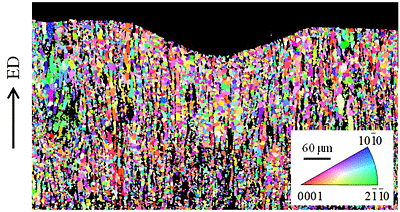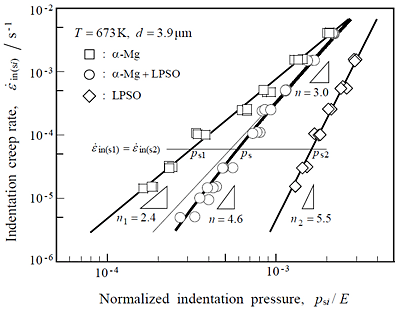Our team has been reporting the interpretation of the high-temperature creep mechanism for dual ductile-phase alloy by theoretical analyses, indentation creep tests, and finite-element simulations. The experimental results suggested that the creep strength of the dual ductile-phase alloy closely followed the rule of mixtures and the isostrain rate conditions. The stress exponent n for creep was expressed by the harmonic mean weighted by the effective volume fractions of the constituent phases, which strongly depended on the deformation rate. In addition, n consistently fell between the corresponding values for the two constituent phases in the power-law creep region. A similar trend was observed for the deformation rate dependence of the creep activation energy Q, which was expressed by the weighted arithmetic mean value. Thus, the values of n and Q quantitatively captured the mechanical contribution of the reinforcing phase to the creep strength of the overall dual ductile-phase alloy. As following, the microstructure of the tested alloy and experimental results of the stress exponent are shown.
Figure 1 shows a representative SEM image of the three-dimensional microstructure of the dual-phase alloy. In the longitudinal section parallel to the extrusion direction (ED), the discontinuous fibrous LPSO phase (light gray) is aligned with the ED in the α-Mg matrix (dark gray). Meanwhile, in the cross-section perpendicular to the ED, the lamellar LPSO phase is uniformly observed in the α-Mg matrix. The area fraction of the α-Mg matrix is ~75% for all cross-sections (i.e., a volume fraction of V1 0.75 for the matrix and V2
0.75 for the matrix and V2 0.25 for the remaining LPSO phase). The values of V1 and V2 are unchanged after heat treatment.
0.25 for the remaining LPSO phase). The values of V1 and V2 are unchanged after heat treatment.
Figure 2 shows the IPF map of the longitudinal section immediately under the indentation mark. In this case, indentation was performed with a conical indenter perpendicular to the cross-section at the highest test temperature of 673 K for a loading time of 5.4 ks. During this loading period, neither recrystallization nor microscopic cracking occurs in the region. These findings show that the indentation creep test is performed on a thermally stable microstructure. Although a small amount of as-worked α-Mg grains exist in the microstructure, it is thought that they have little influence on the cross-sectional indentation test results.
Figure 3 shows double logarithmic plots of ε ’in(si) versus psi/E for the α-Mg alloy, the LPSO alloy, and the dual-phase alloy. Here, ps1 of the α-Mg alloy is the lowest, ps2 of the LPSO alloy is the highest, and ps of the dual-phase alloy is consistently located between them. In the case of single phase alloy of α-Mg or LPSO alloy, the data points follow different straight lines. The gradient line for α-Mg alloy corresponds to n1 = 2.4, and it for LPSO alloy is n2 = 5.5. In contrast, The data points for the dual-phase alloy follow a continuous curve, when ε ’in(si) decreases from 4.5 ![]() 10-3 s-1 to 1.0
10-3 s-1 to 1.0 ![]() 10-4 s-1, n increases from 3.0 to 4.5. The n value of dual-phase alloy gradually approach the corresponding value of the LPSO phase (n2 = 5.5) as the deformation rate decreases. These findings indicate that the characteristic creep parameters of dual-phase alloy cannot be explained using the traditional creep theory for single-phase alloys.
10-4 s-1, n increases from 3.0 to 4.5. The n value of dual-phase alloy gradually approach the corresponding value of the LPSO phase (n2 = 5.5) as the deformation rate decreases. These findings indicate that the characteristic creep parameters of dual-phase alloy cannot be explained using the traditional creep theory for single-phase alloys.
Additional results in this paper are as follows:
| • |
During the creep of the LPSO phase, the basal <a> slip system was dominant. However, the steady-state creep behaviors of the LPSO phase could not be explained using the conventional creep theory for single-phase alloys. Meanwhile, GBS occurred in the fine-grained α-Mg matrix, so that the strain component in the c-axis direction of the α-Mg grains could be compensated for maintaining the ductility. |
| • |
The creep characteristic values n and Q of the dual-phase alloy strongly depended on the deformation rates, which were intermediate between the corresponding values of the two constituent phases in the power-law creep region. The magnitude of the load shared by the LPSO phase varied following the effective volume fraction in the mixing rule and as a function of the deformation rate. |
| • |
The values of n and Q were theoretically predicted using the creep properties of single-phase alloys with the same composition as the constituent phases. The mechanical contribution of the LPSO phase to the creep strength of the overall dual-phase alloy could be estimated from the creep characteristic values of the alloy. |
| • |
In the power-law creep region, the LPSO phase effectively suppressed deformation of the α-Mg matrix by composite reinforcement, thereby achieving high creep strength. In addition, the bridging phenomenon occurred in the dual-phase alloy, yielding a high reinforcement efficiency. |
| • |
To further improve the creep strength of the dual-phase alloy, it is effective to increase the toughness and reinforcement efficiency of the LPSO phase. It is important to develop a method for elucidating the high-temperature creep mechanism of such an alloy, thereby reducing the development times of new materials with complicated structures. |


